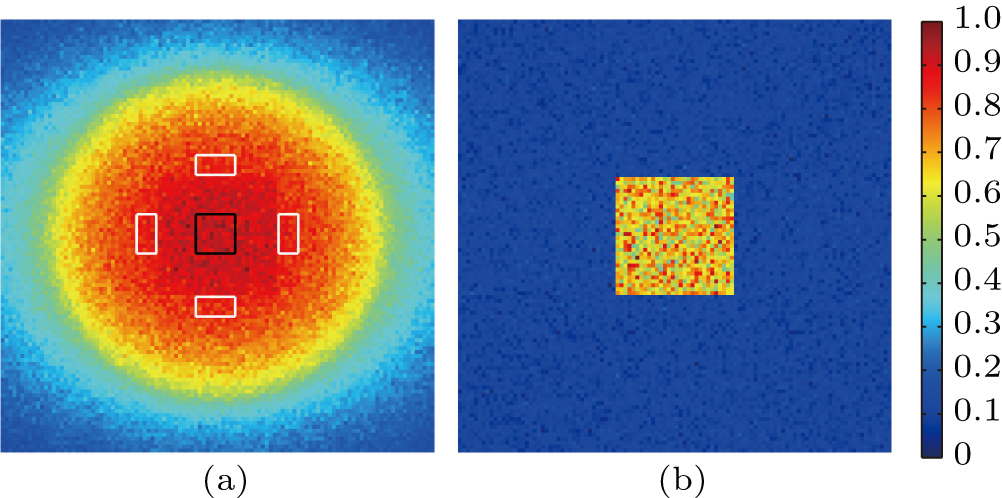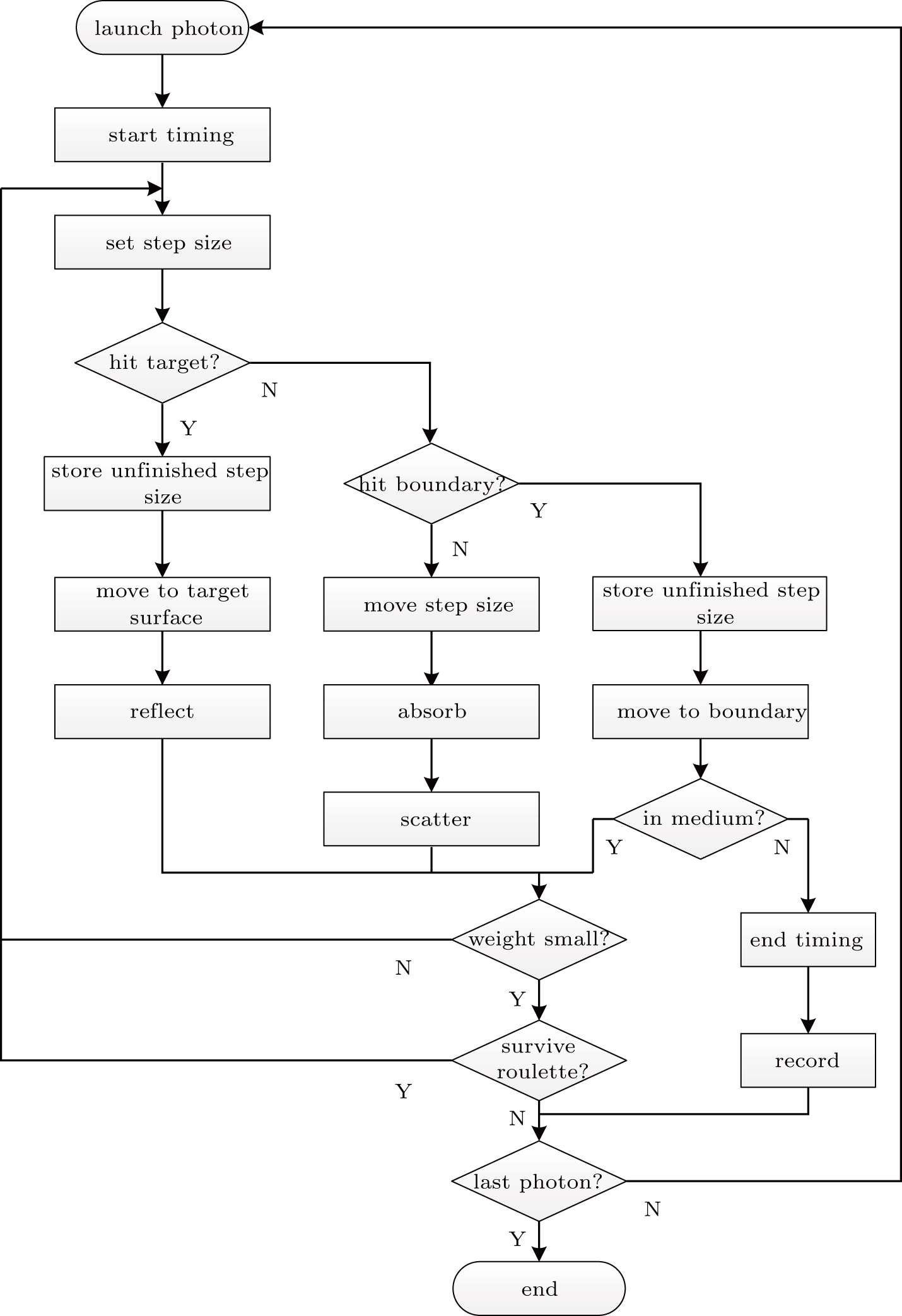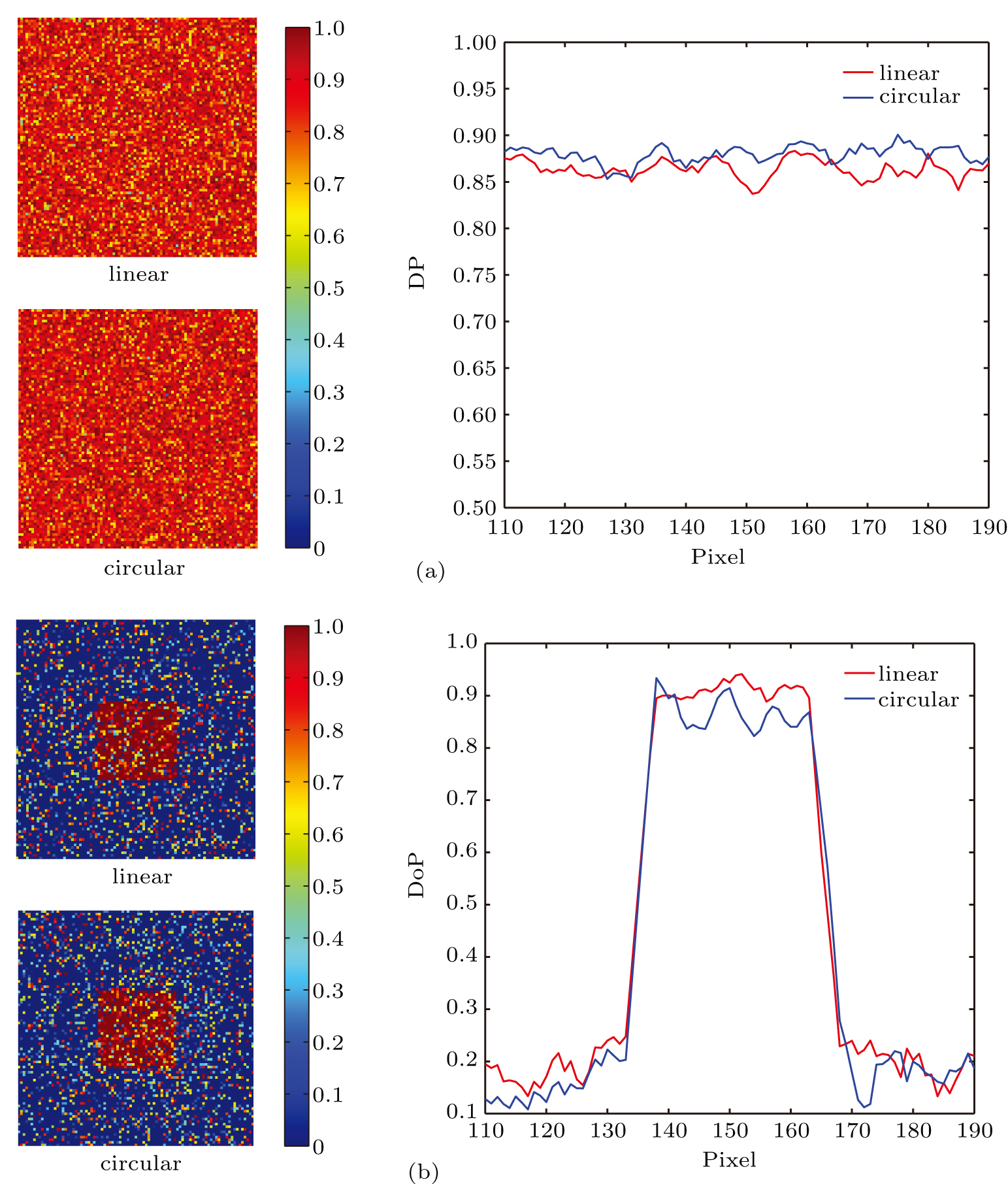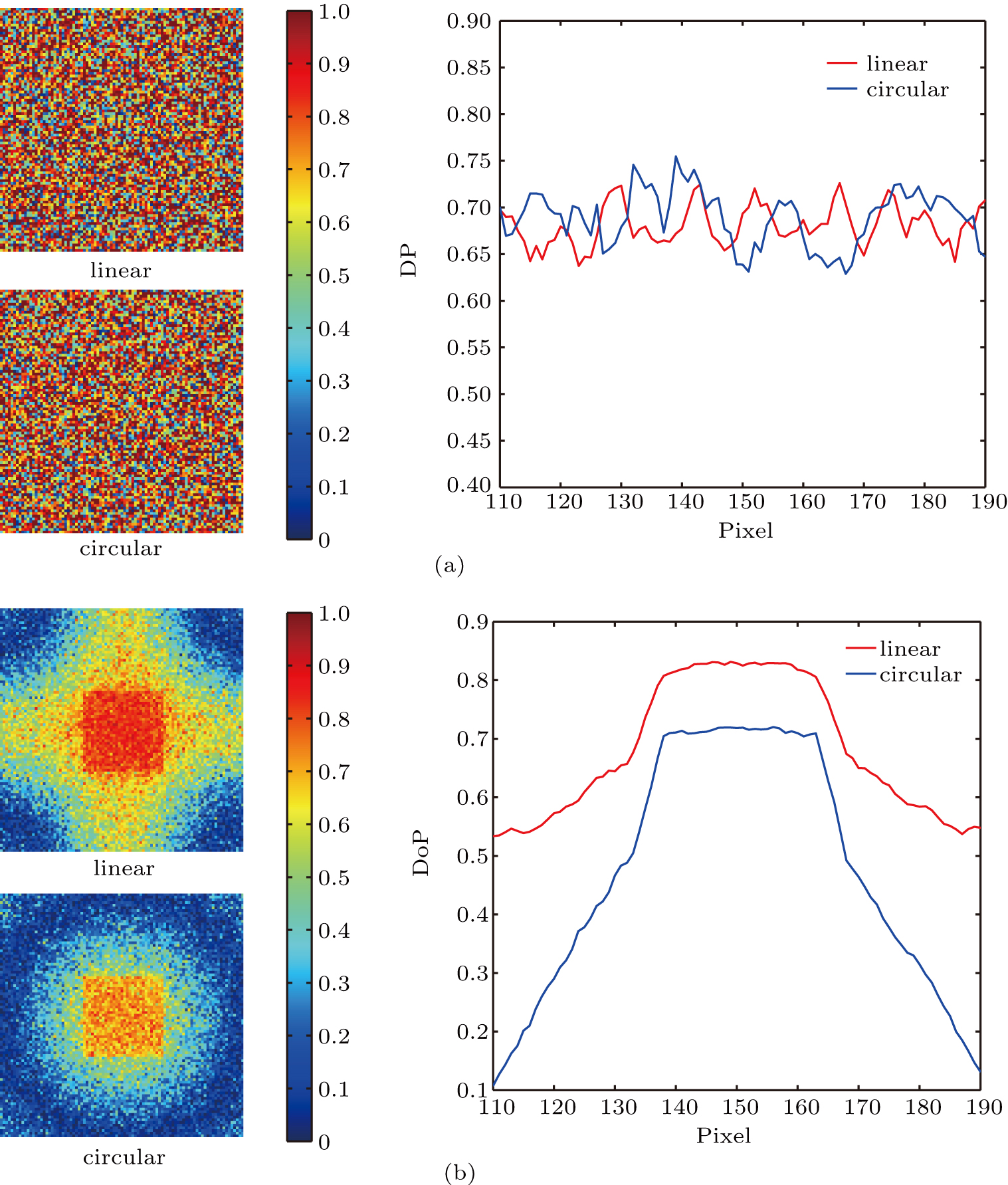† Corresponding author. E-mail:
Project supported by China Postdoctoral Science Foundation (Grant No. 2016M592788) and the Natural Science Basic Research Plan in Shaanxi Province of China (Grant No. 2018JM6008).
We have investigated the effect of size parameter of the scatterer on the image quality obtained with polarization-based range-gated imaging in birefringent turbid medium. Both linearly and circularly polarized light were utilized for imaging. The simulated results indicate that the improvement of visibility is more pronounced using circularly polarized light for the birefringent medium composed of smaller-sized scatterers at lower values of optical thickness and the birefringent medium comprising larger-sized scatterers. In contrast, linearly polarized light provides better image quality for the birefringent medium composed of smaller-sized scatterers at larger values of optical thickness. The evolution of the polarization characteristics of backscattered light and target light under the conditions mentioned above was measured to account for these numerical results.
Obtaining clear images of a target embedded in a turbid medium by means of optical techniques has potential applications in atmospheric remote sensing, underwater imaging, and biomedical diagnostics. The main difficulty encountered in optical imaging is the fact that scattered light leads to image blurring. There has been a growing interest in developing novel approaches to improve the contrast and resolution in optical scattering environment. For instance, time gating,[1] coherence gating,[2] and frequency domain gating[3] have been proposed to extract unscattered or weakly scattered photons based on the parameters of photon such as propagation time and phase. Recently, polarization imaging has been widely utilized to detect the target embedded in the turbid medium[4–10] because of the simplicity of experimental setup such as polarimeter[11] and the capability to reject unwanted photons. The feasibility of polarization imaging is sensitively influenced by the difference in the polarization state of light experiencing different scattering events, which depends upon a variety of optical properties of the turbid medium, including the scattering coefficient, the absorption coefficient, the anisotropy factor, the size of scatterer, and the refractive index.[12] The relationship between the polarization characteristics of scattered light and the optical properties of turbid medium is quite complicated. Thus, investigating the influence of the variations in optical properties of turbid medium on the validity of polarization imaging is required for its implementation and several studies have been carried out by means of theoretical analysis, Monte Carlo simulation, and experimental investigation.[13–17]
Generally, birefringence is a prevalent phenomenon exhibited in a turbid medium, especially in biological tissue.[18] Detailed analyses of the evolution of polarized light in a birefringent medium has also been made. In Ref. [19], the authors developed Monte Carlo algorithm to investigate the spatial distribution of the polarization state of the light backscattered from the birefringent turbid medium for the cases of linearly and circularly polarized incident light. They also presented the dependence of the polarization characteristics of light on the birefringent parameters.[20] Otsuki proposed a double-scattering model that represents the geometry of photon propagating in turbid infinite plane medium to study the multiple scattering of polarized light in a birefringent turbid medium.[21] Baravian et al. focused both experimentally and theoretically on the relationship between the backscattered Mueller matrices and the birefringence of turbid medium.[22] Through simulation and experiment, Alali et al. examined the symmetry properties of the transmission Mueller matrix in the bilayered medium with different uniaxial orientation in each layer. These research results will be of benefit to the applications of polarization imaging.[23]
Polarization-based range-gated imaging (PR), which is the combination of polarization–difference imaging and range-gated technology, has been developed to further enhance the visibility of target by suppressing the background photons.[24] When PR is utilized for target detection in turbid medium, additional background photons could be filtered out by polarization–difference imaging after partial background photons being filtered out with the aid of range-gated technology.[25] The optical parameter of turbid medium also affects the feasibility of PR. Consequently, it is necessary to make the systematic analysis of the influence of these parameters on the image quality using PR. We have concluded that PR is significantly affected by the particle size and the polarization state of incident light for the isotropic medium in previous studies.[26] In this work, we present a quantitative study of the relation between the size parameter of scatterer and the image quality obtained by PR in the birefringent medium though Monte Carlo method so that a better understanding of the effective method for target detection could be exhibited, which may provide useful insights for using PR.
The rest of this paper is organized as follows. In Section
In the simulation, a parallel beam with a wavelength of 632.8 nm in vacuum and a radius of 0.28 cm was vertically injected into a semi-infinite birefringent plane medium with an upper boundary. The x and y axes being in the upper boundary of the medium and the z axis being the normal of the upper boundary pointing toward the inside of the turbid medium formed a Cartesian coordinate system. Because the scatterers contained in the turbid medium, such as cell and cell organelle, are close in shape to a sphere,[27] spherical particles were used in this investigation. Suspensions of monodispersed polystyrene microspheres with the diameters of 0.11 μm and 2.00 μm in water were used to simulate the turbid medium. The refractive index of scatterer np was 1.59 and the refractive index of surrounding nm was 1.333. The anisotropy parameters were 0.092 and 0.914, respectively. The absorption coefficient of the scattering medium was 0.05 cm–1. To simplify the simulation, the target was modeled as a reflective parallelepiped having a size of 0.2 cm×0.2 cm×0.1 cm along the x axis, y axis, and z axis. The refractive index of the target nt was 1.51. Considering the light attenuation in the turbid medium, the imaging distance was set to 3.5 cm, which was defined as the distance between the upper boundary of turbid medium and the top surface of target. Therefore, the optical thickness τ can be adjusted by varying the scatterer concentration.
In this study, the birefringence of turbid medium was assumed to be positive, so that the ordinary refractive index no is lower than the extraordinary refractive index ne. The birefringent value Δn was 4.0×10–4 according to the parameter in biological tissue[20] and the birefringence slow axis was along the z axis.
Monte Carlo simulation has turned out to be a robust approach to investigate the propagation of polarized light in the scattering medium. In the PR Monte Carlo simulation, photons are traced in the medium with known optical properties. Figure
In our simulation, from the respect of the reliability of the results and the efficiency of the simulation process, the photon number was set to 5×107. Each result was written in the form of matrix whose size is 300 × 300 and presented as a two-dimensional image with 2 cm on each side.
In Fig. 

 | Fig. 2. (color online) Images obtained by intensity imaging (a) and L-PR (b) in the birefringent medium composed of 0.11-μm diameter scatterers having a value of τ = 1.50. |
The image quality could be quantitatively evaluated by the image contrast defined as (Imax–Imin)/(Imax+Imin). Here, Imax and Imin represent the intensities of target and background calculated by averaging the intensity of the target center area marked by the black square containing 100 pixels and the intensities of the four designated areas containing 50 pixels, respectively, marked by the white rectangles outside the target area in Fig.
 | Fig. 3. (color online) Variation of contrast with optical thickness acquired using intensity imaging (I), L-PR, and C-PR in the birefringent medium composed of 0.11-μm diameter scatterers. |
Linearly and circularly polarized light, which are two types of incident light, are commonly utilized for active polarization imaging. In order to present their evolution in the birefringent medium, the images obtained by PR using circularly polarized photons (C-PR) were also recorded for the two samples with small-particle as well as large-particle respectively at each optical thickness and compared with the L-PR images under the same condition. The comparison of the contrast profiles for L-PR image and the image obtained by C-PR (C-PR image) in the birefringent medium containing 0.11-μm diameter scatterers is displayed in Fig.
Investigating the distributions of DoP and DP could provide an easy and effective way for accounting for the trend in distribution of image contrast. DoP is calculated by (I∥–I⊥)/(I∥+I⊥).[7] I∥ and I⊥ are the intensities of the light parallel and perpendicular to incident polarization for the case of linear polarization and the intensities of the light of the same and opposite helicity as the incident light for the case of circular polarization. DP is calculated by 1–DoP.[27] It is pertinent to note that the amount of backscattered light (the light entering the detector before colliding with target due to the backscattering behaviors and making up the main part of background light) filtered out by range-gated technology because the propagation time relies on the photon path and propagation speed, is not related to the polarization state of incident light. As a result, it is polarization–difference imaging that determines the image quality obtained by PR. Note that, in PR, polarization–difference imaging is implemented after the implementation of range-gated technology in PR. Therefore, the polarization characteristic expressed in the form of the images and profiles of DoP and DP should be measured after the implementation of range-gated technology to analyze the image quality.
For the case of lower optical thickness, 
In addition to the backscattered light, the light reflected from the target (target light) also has significant influence on the image quality. Thus, it is necessary to measure DoP of the target light, which is displayed in Fig.
For the case of higher optical thickness, 
Figure
Figure 
 | Fig. 6. (color online) Variation of contrast with optical thickness acquired using L-PR and C-PR (C-PR) in the birefringent medium composed of 2.00-μm diameter scatterers. |
Figure
In summary, we have studied the image quality obtained by PR in the birefringent turbid mediums composed of smaller-sized and larger-sized scatterers with the aid of Monte Carlo simulation. We have shown that the image quality is significantly influenced by the scatterer size and the polarization state of incident light. For the scattering medium prepared using smaller-sized scatterers, the contrast is related to the optical thickness. C-PR yields better image quality under the condition of lower optical thickness while L-PR could do more efficiently under condition of higher optical thickness. In the medium prepared using larger-sized scatterers, circularly polarized light leads to a more noticeable enhancement of contrast as compared with linearly polarized light for all values of optical thickness. The contributions of backscattered light and target light on the image quality are analyzed by measuring their polarization characteristics expressed in terms of DoP and DP. These give a plausible explanation for the simulated results that could provide guidance for the practical application of PR, such as the selection of the appropriate polarization state of incident light according to the size of scatterer. Our further work will include a systematic investigation regarding the influence of the variation of birefringence and the type of target on PR. The simulated results should also be verified through an experimental study.
| [1] | |
| [2] | |
| [3] | |
| [4] | |
| [5] | |
| [6] | |
| [7] | |
| [8] | |
| [9] | |
| [10] | |
| [11] | |
| [12] | |
| [13] | |
| [14] | |
| [15] | |
| [16] | |
| [17] | |
| [18] | |
| [19] | |
| [20] | |
| [21] | |
| [22] | |
| [23] | |
| [24] | |
| [25] | |
| [26] | |
| [27] | |
| [28] |





